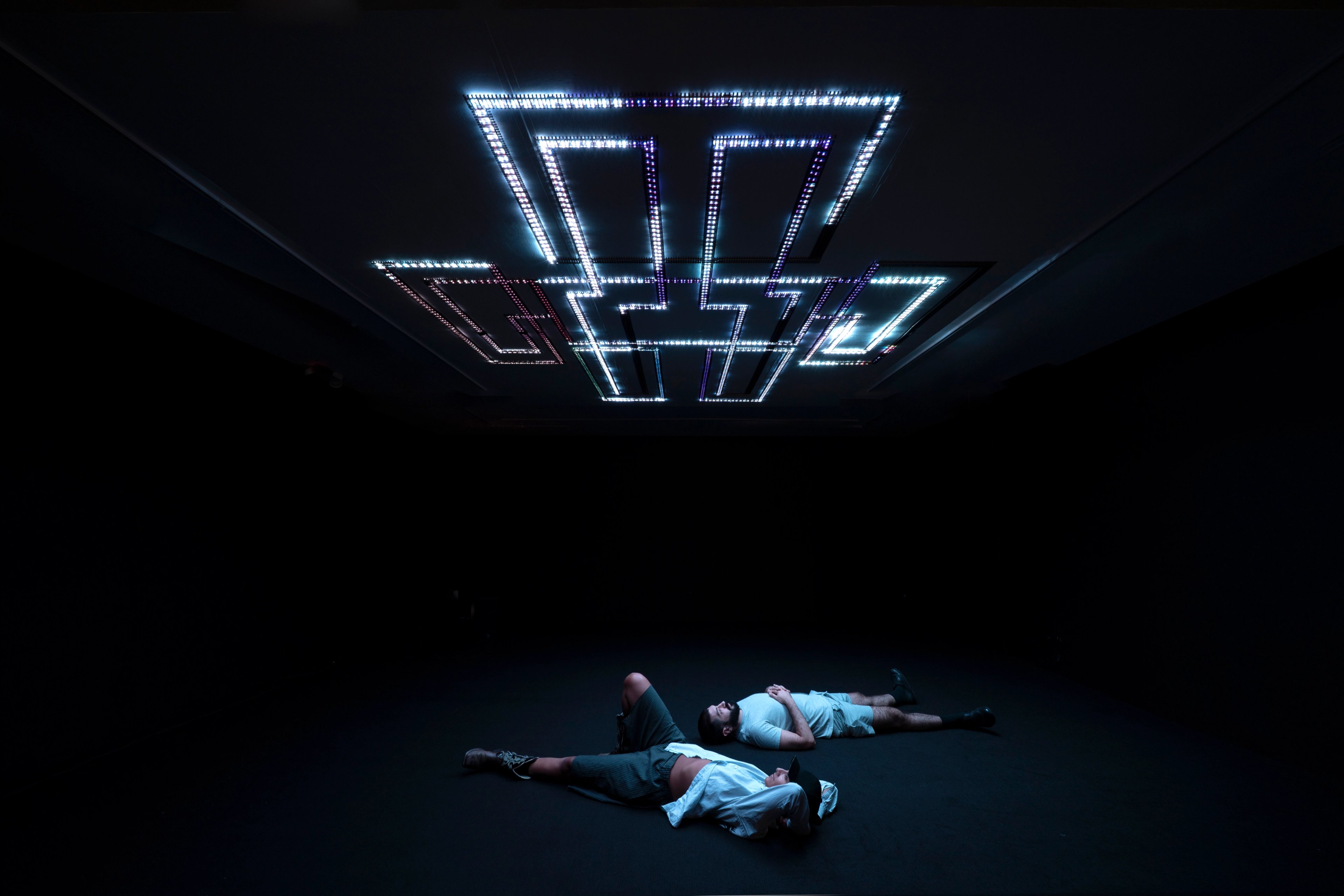
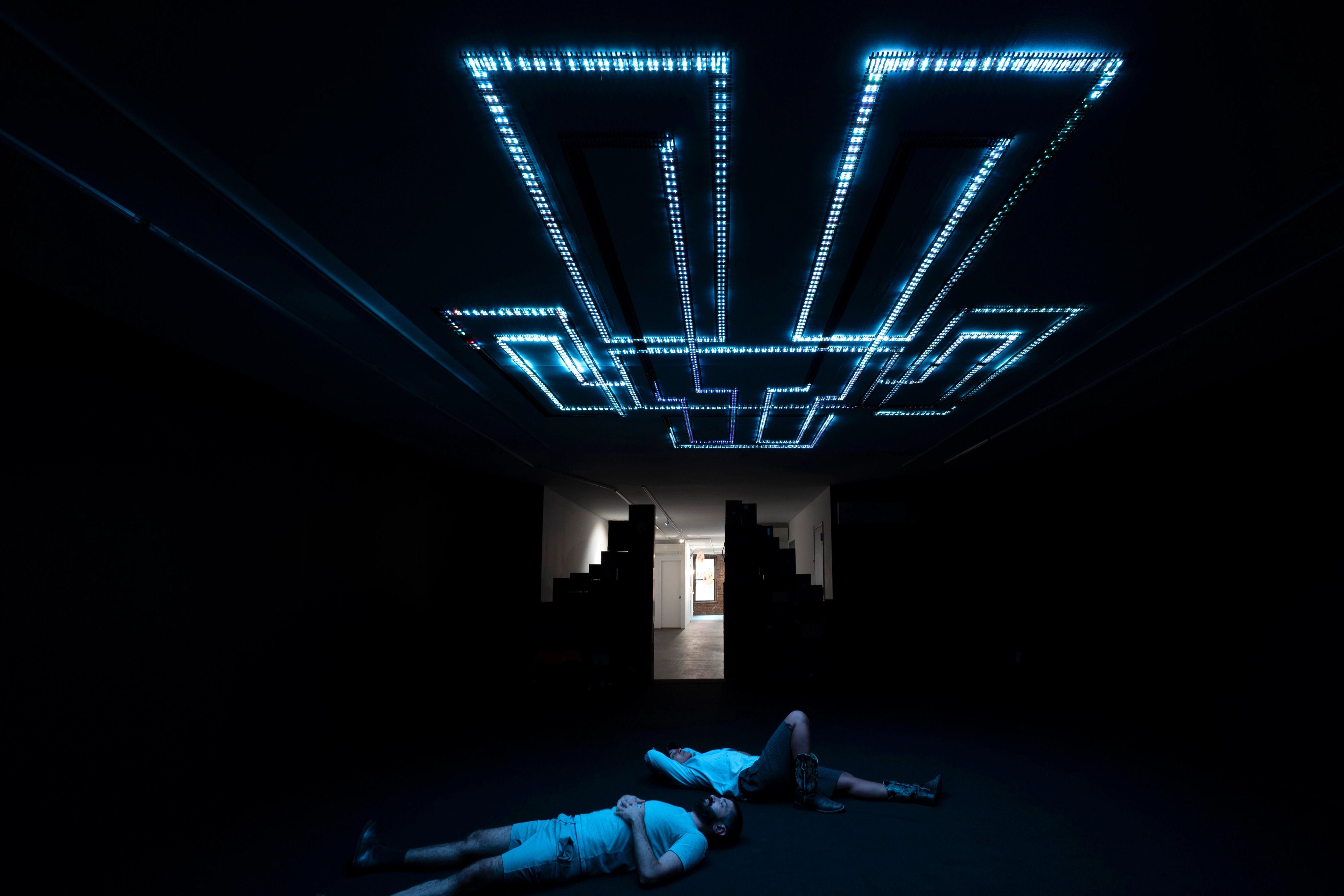

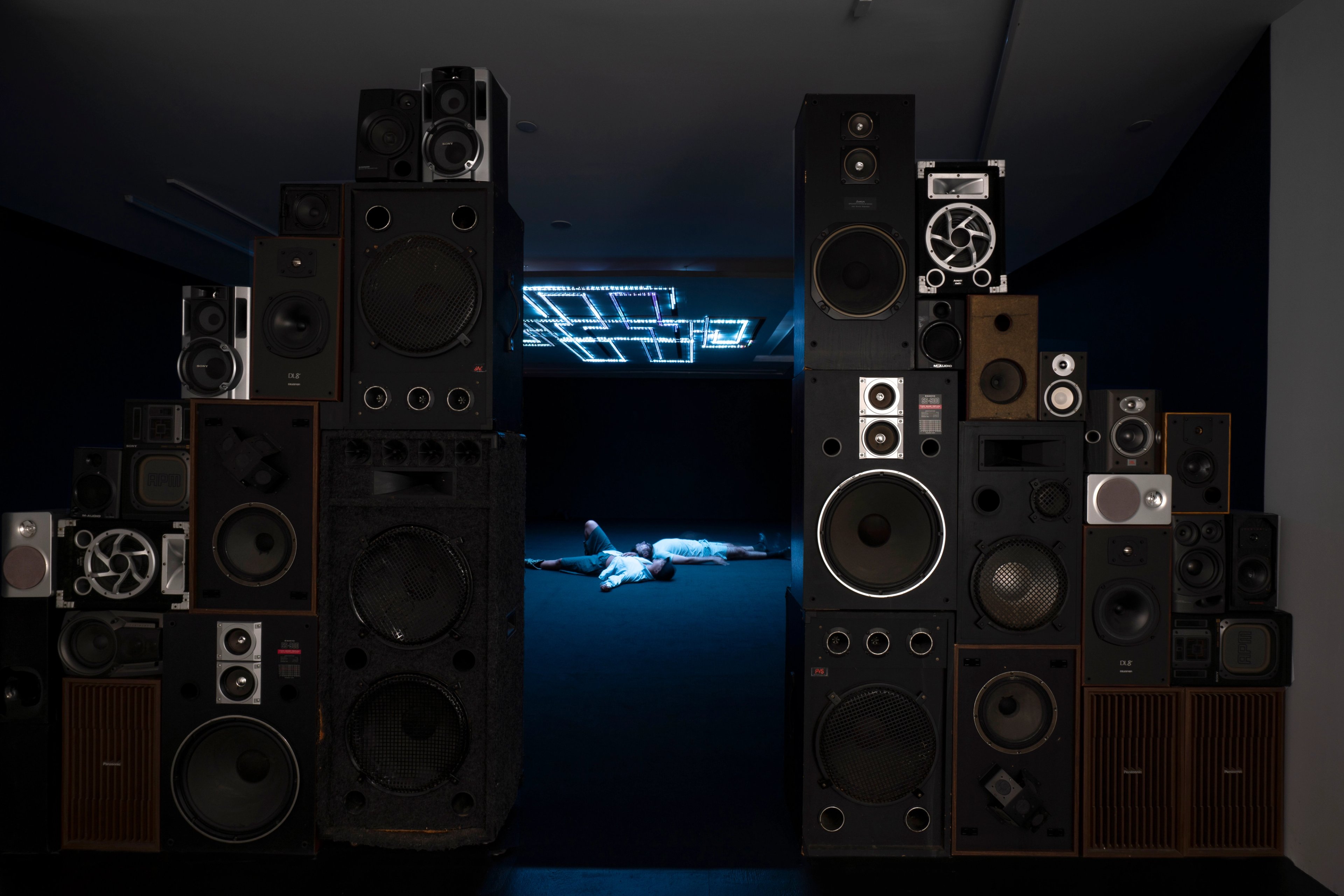
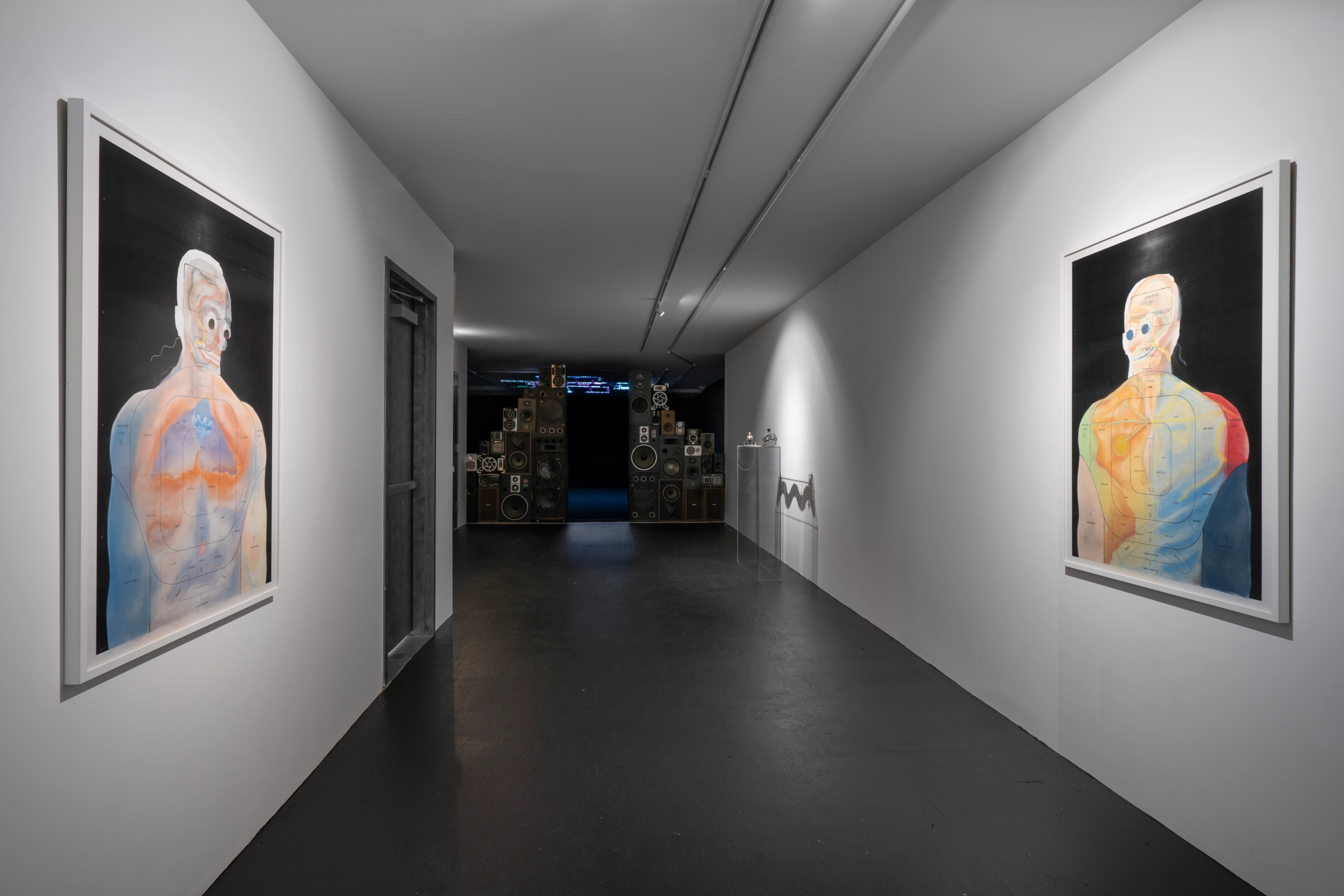
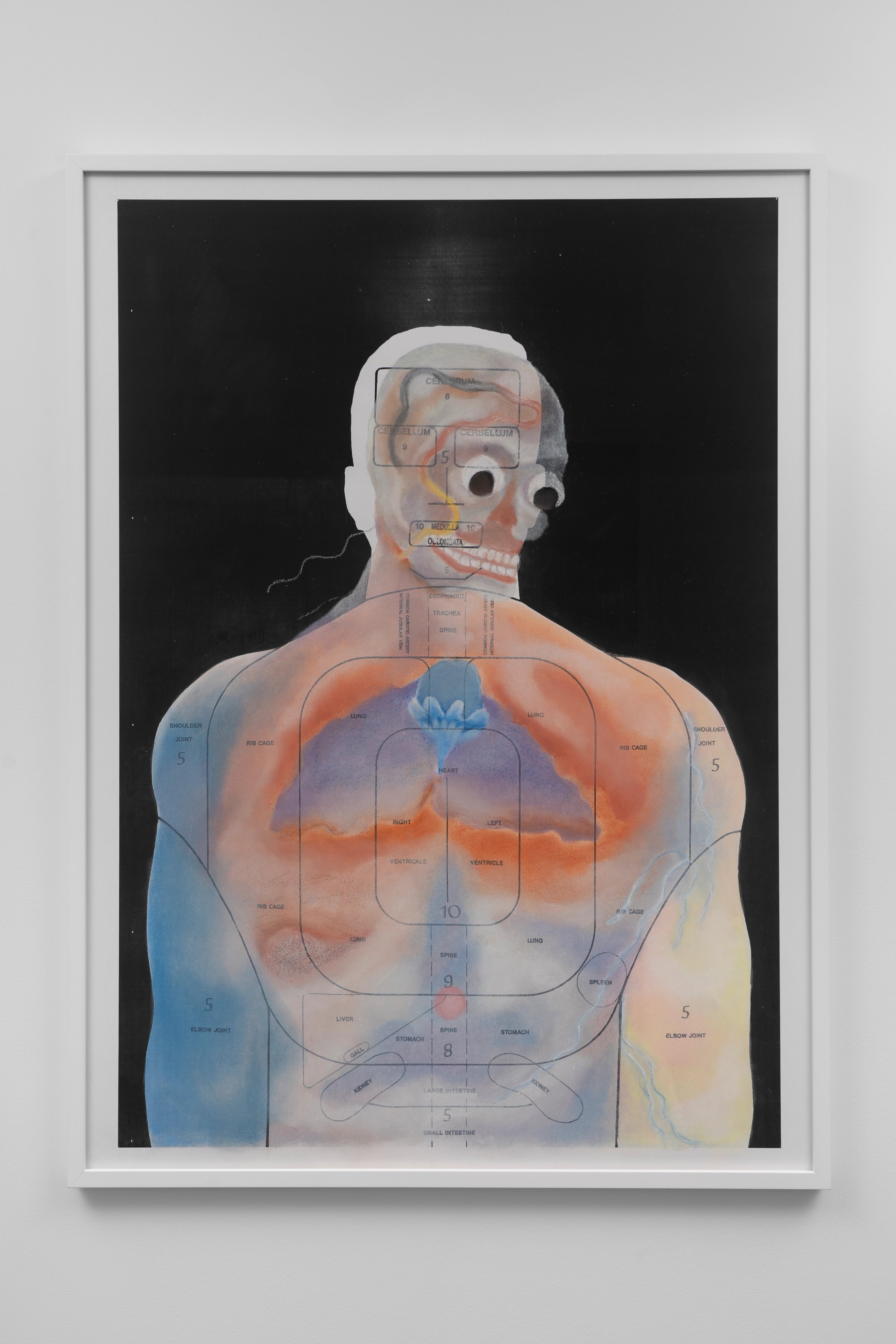
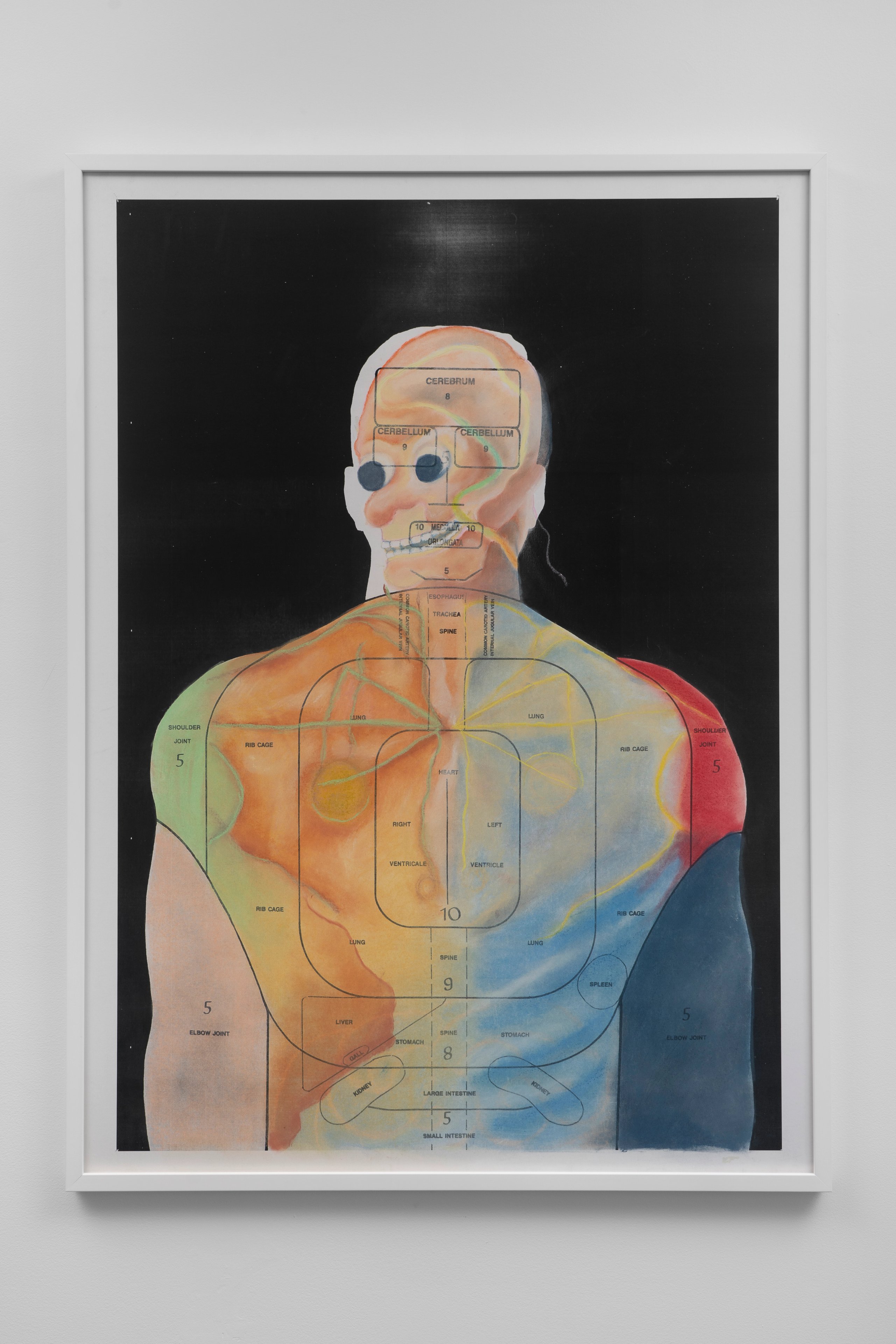
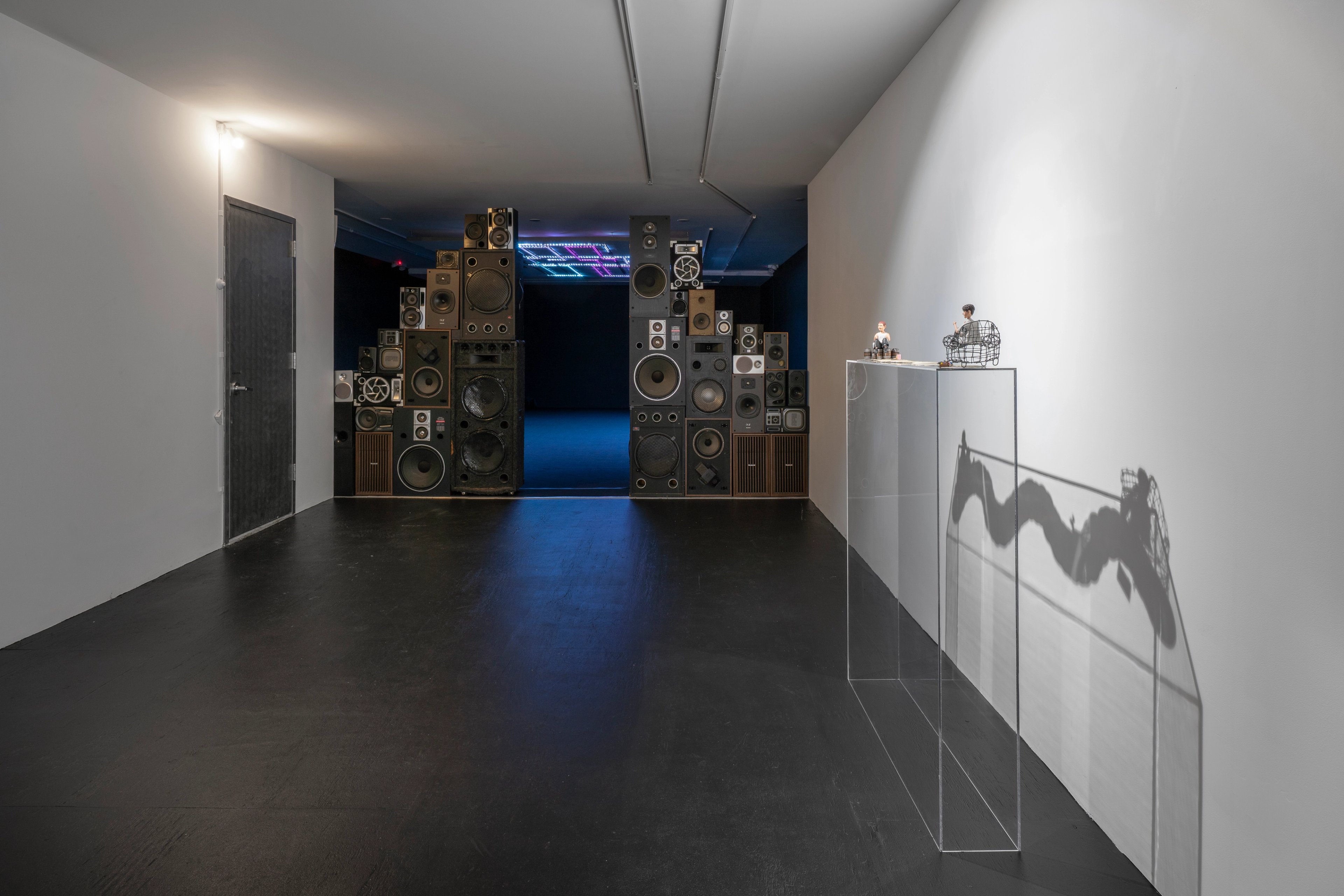
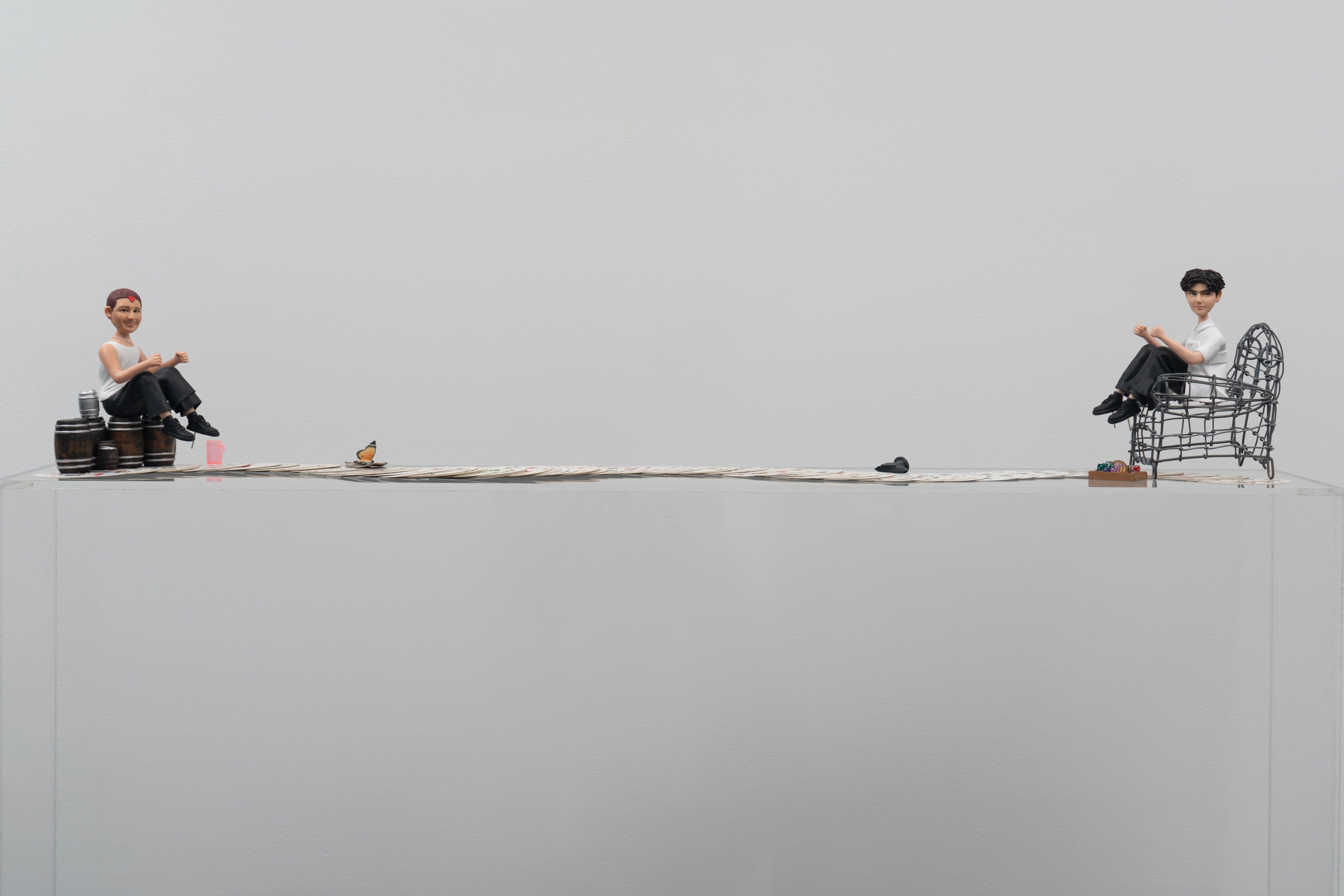
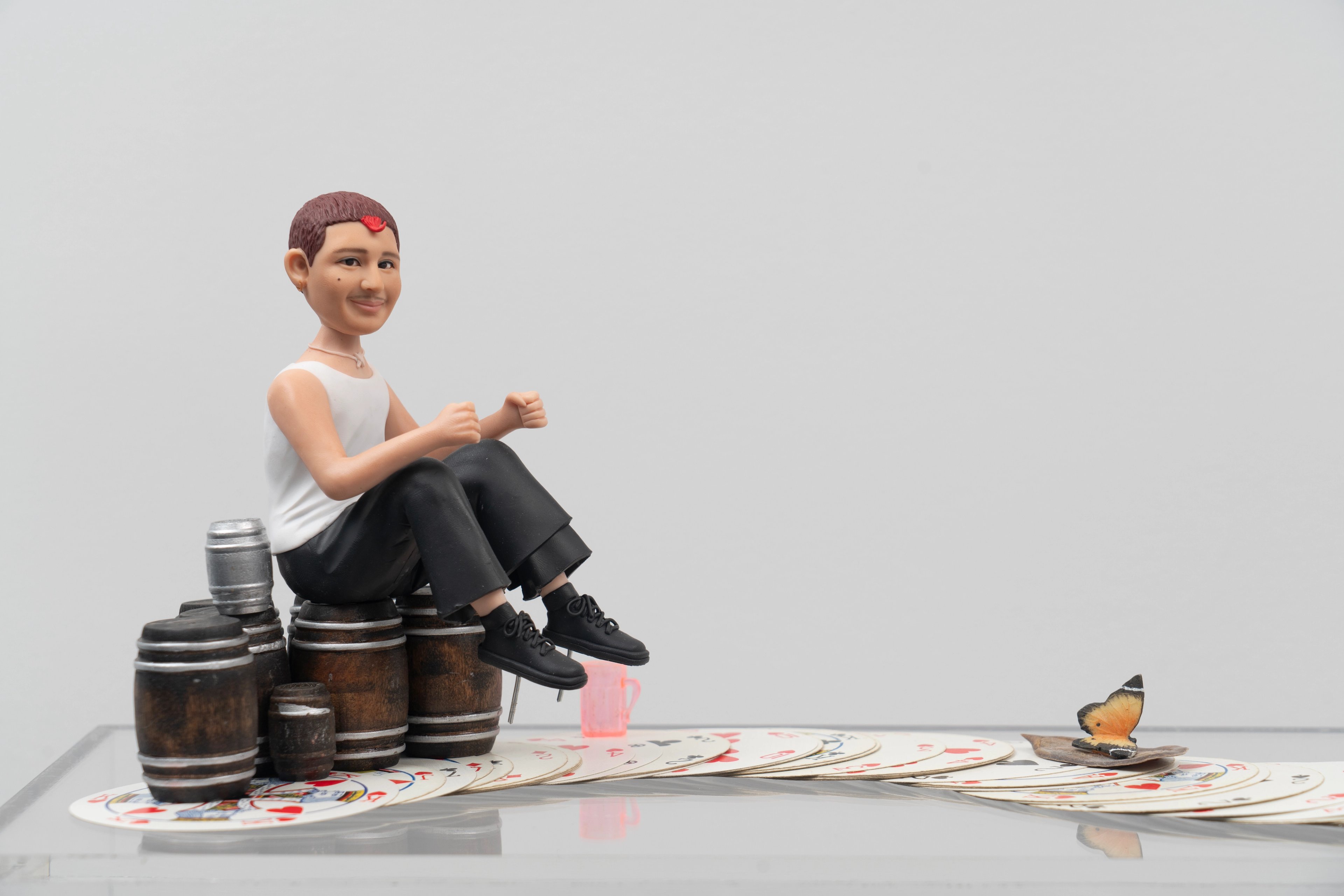
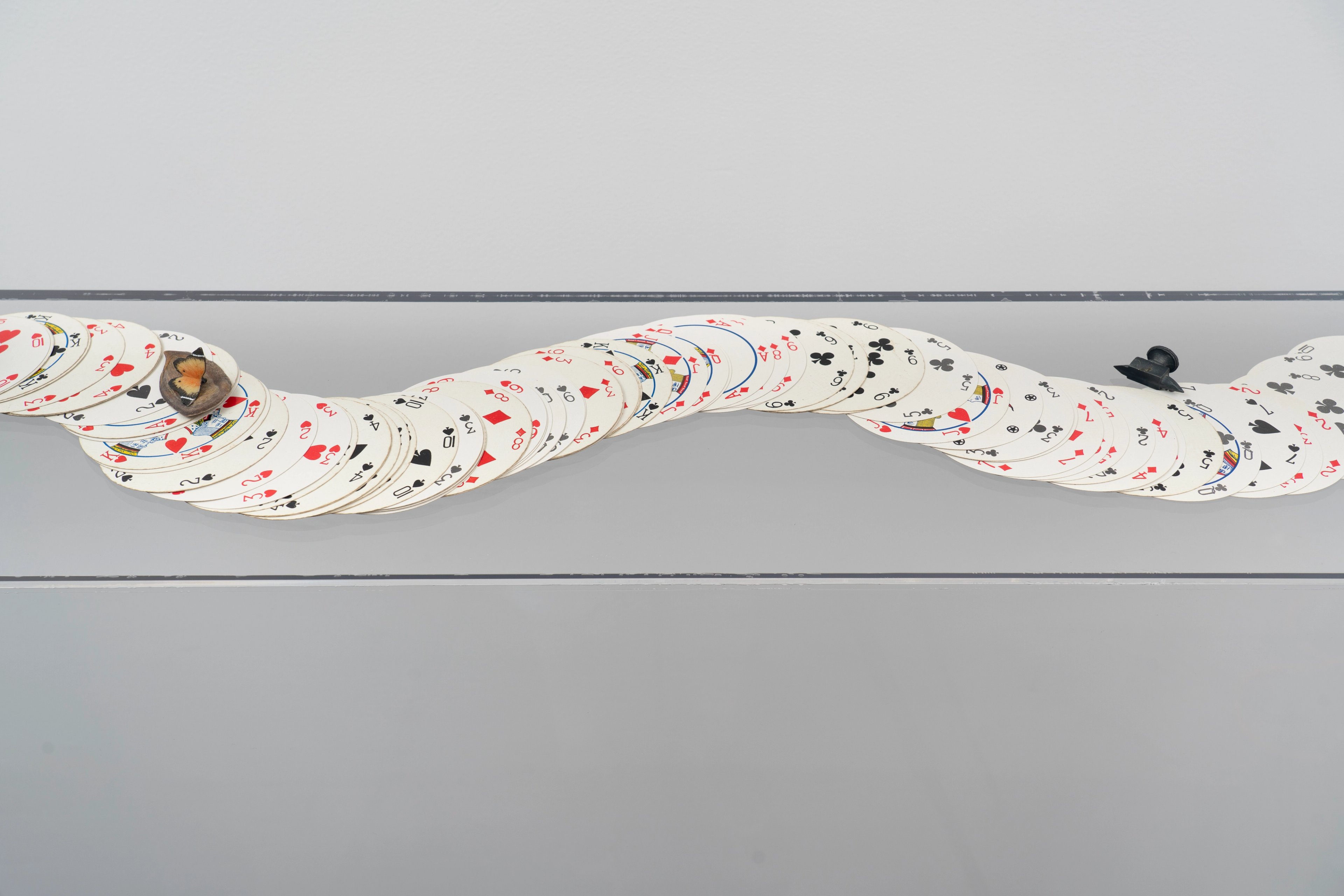
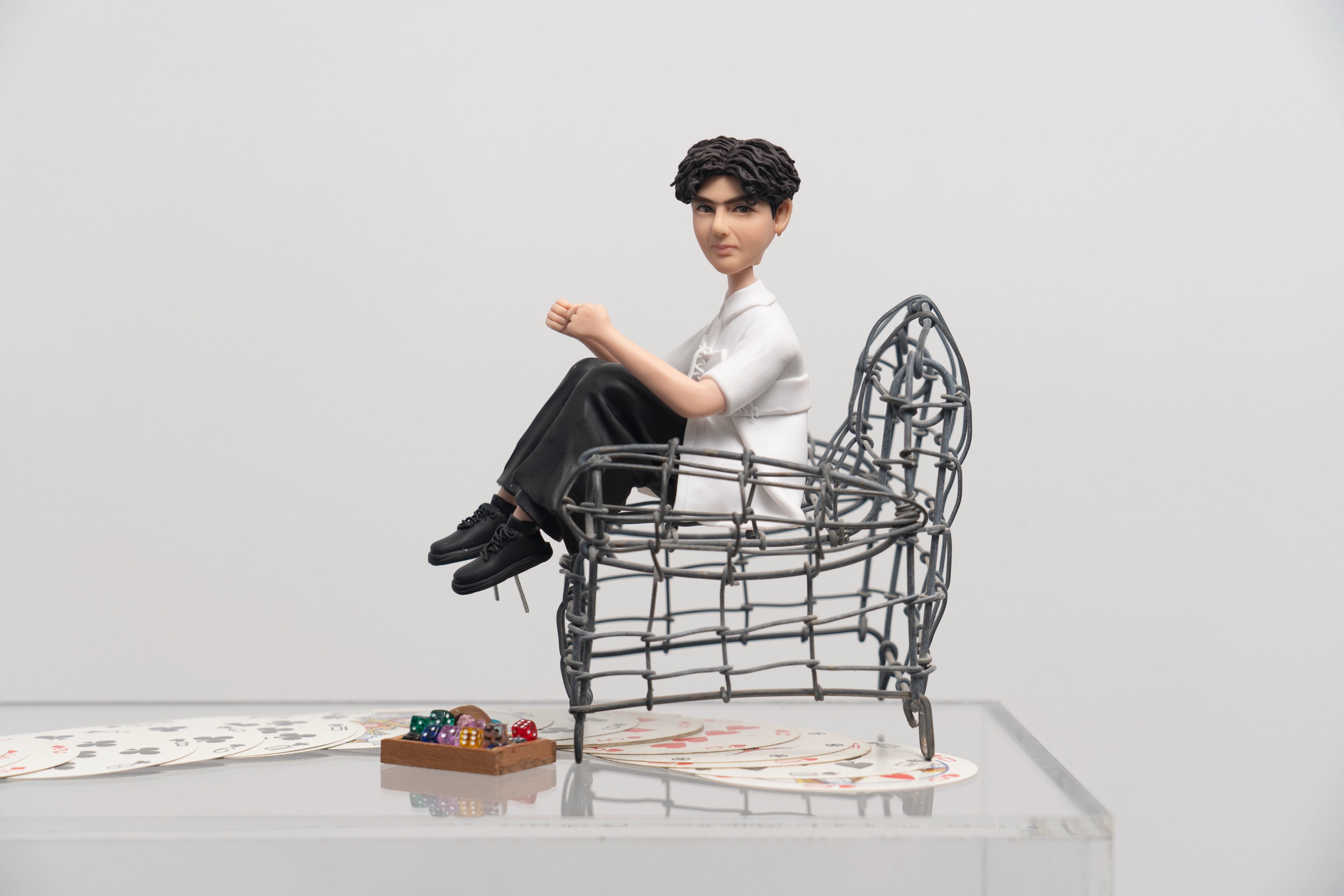
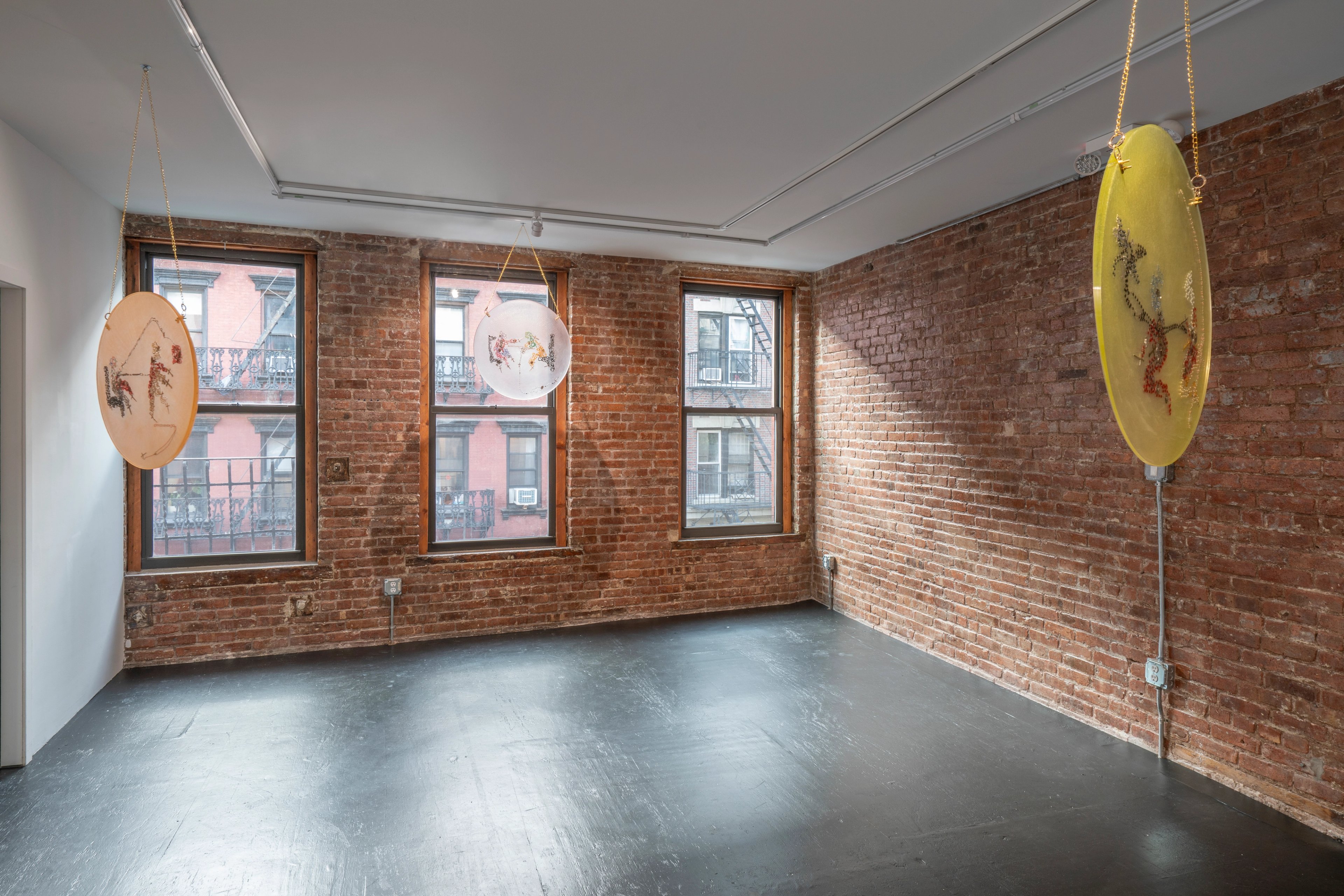
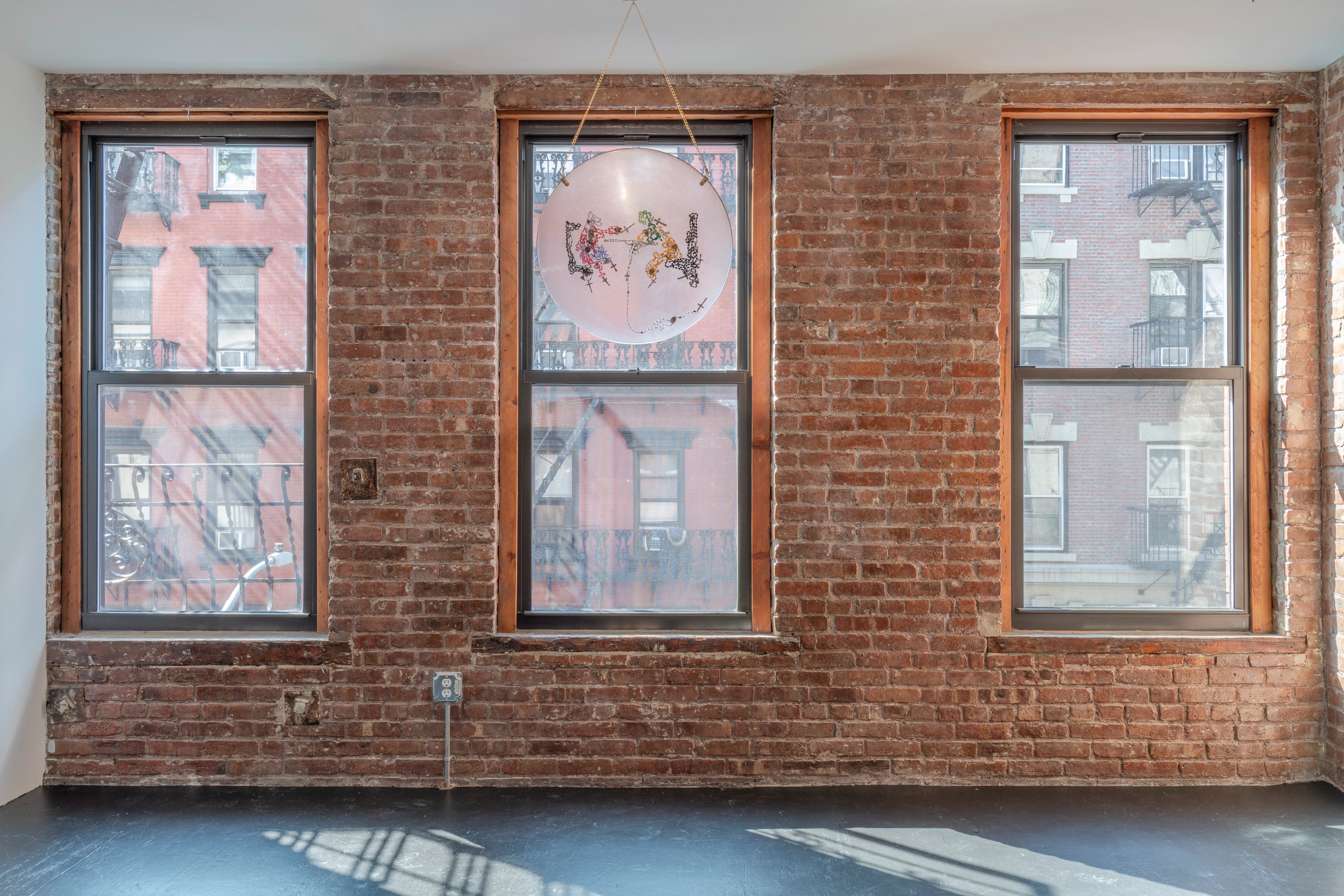
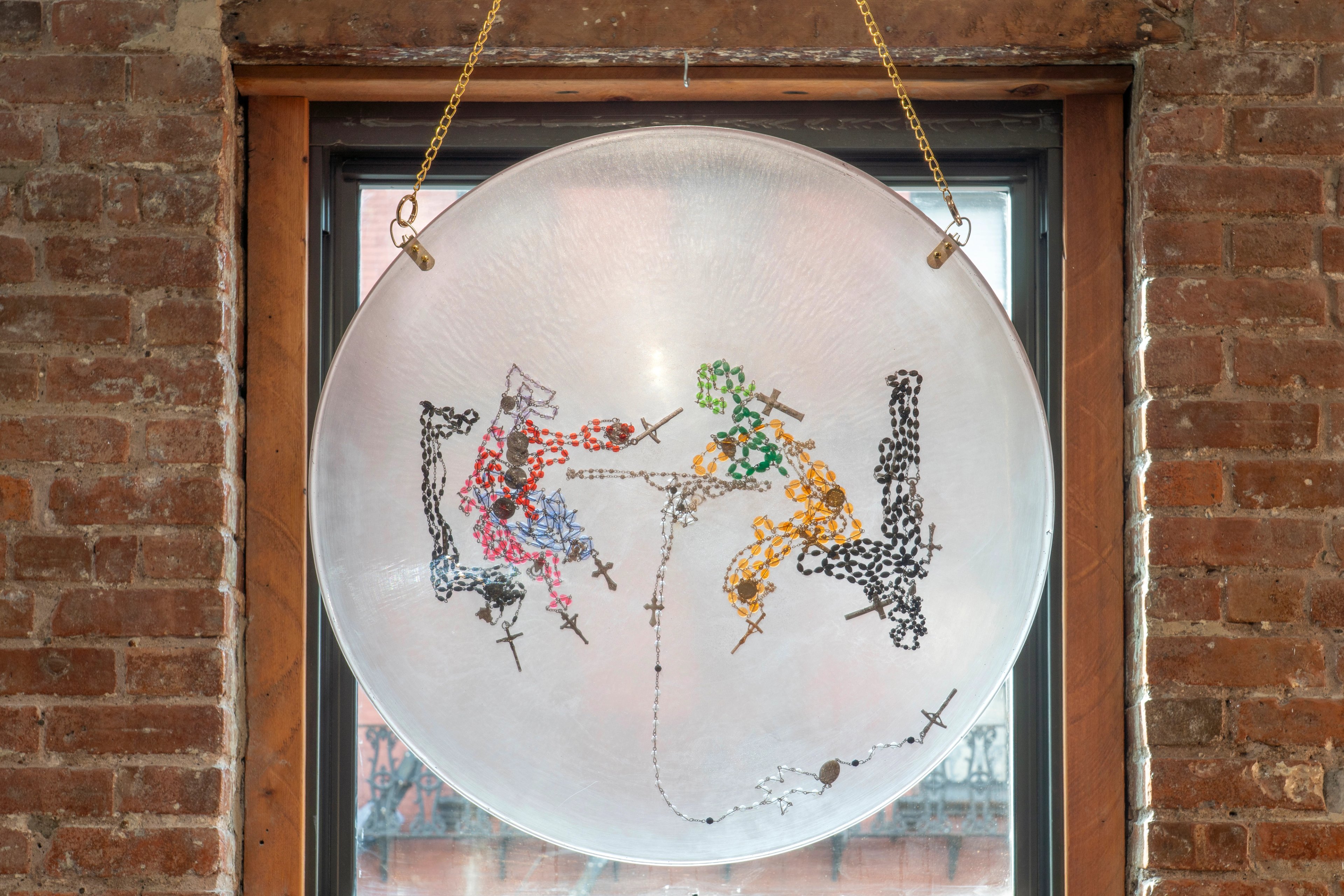
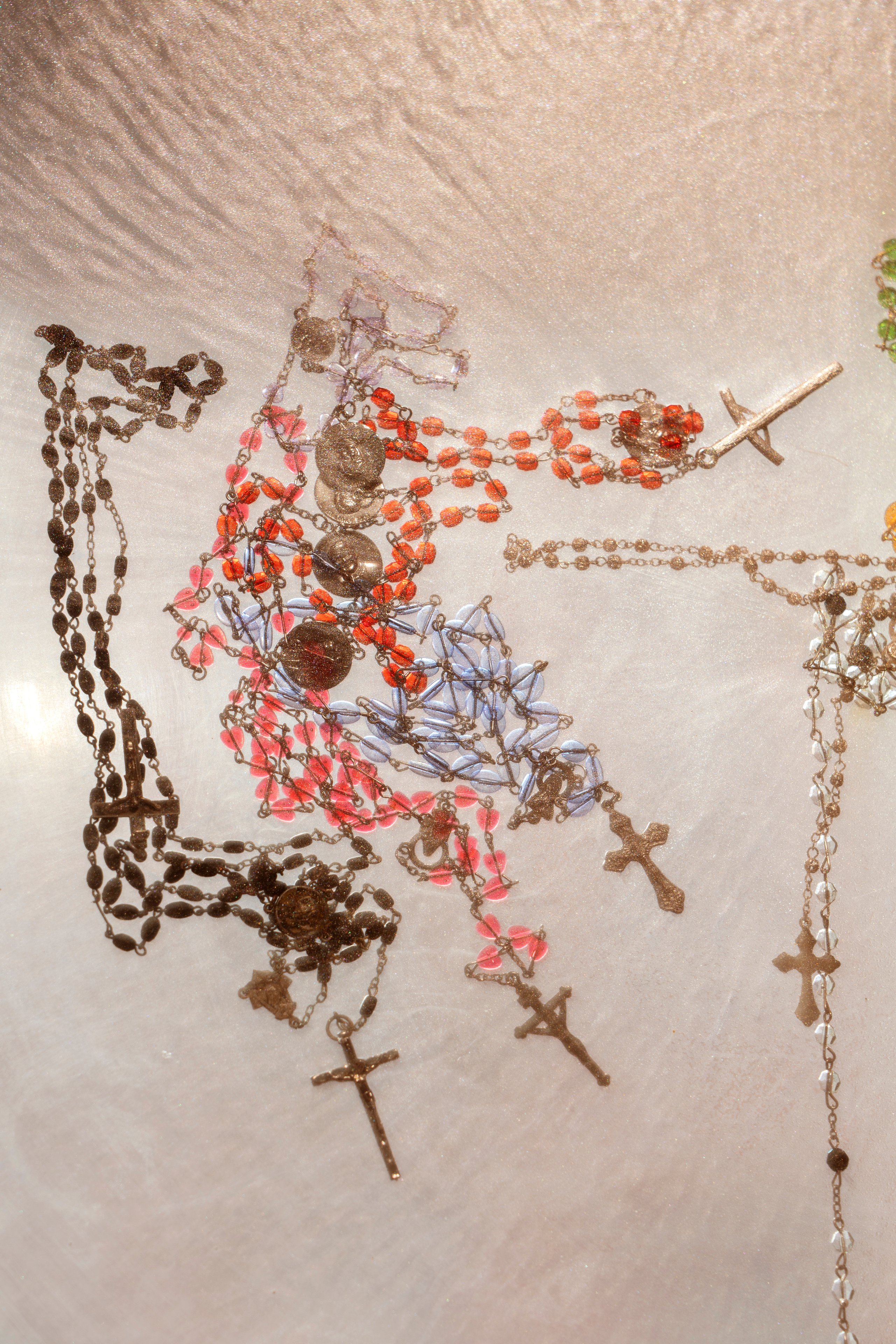
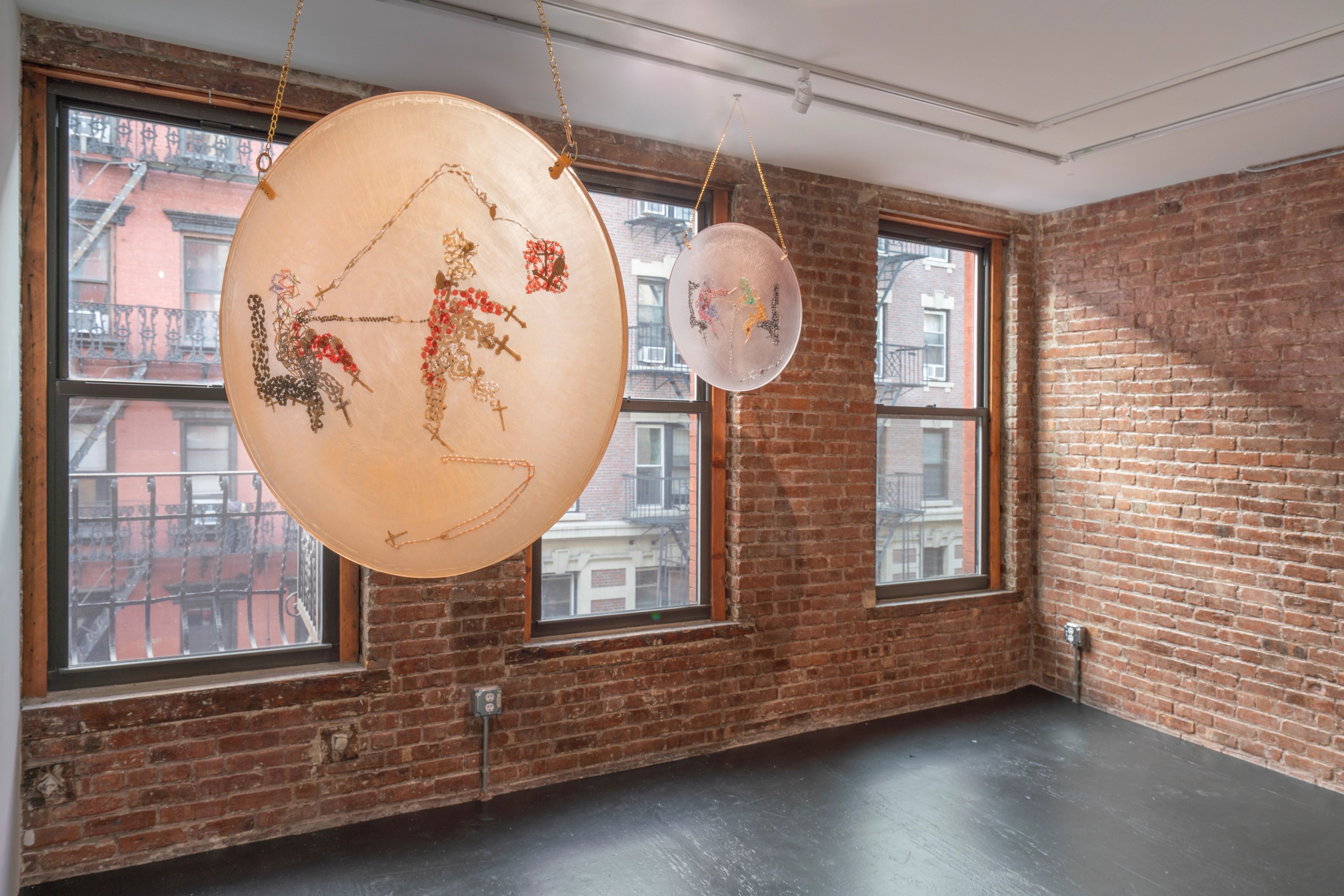
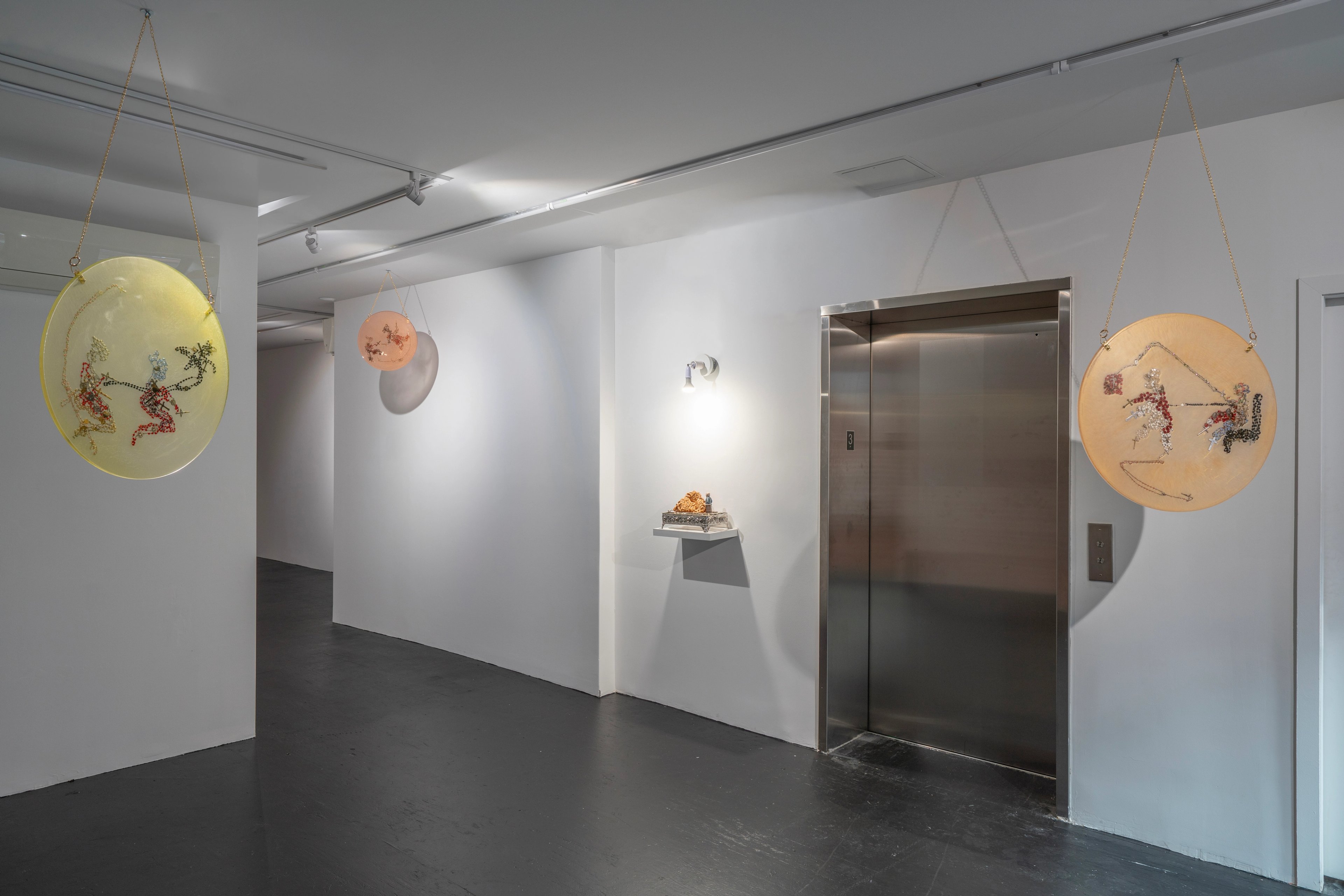
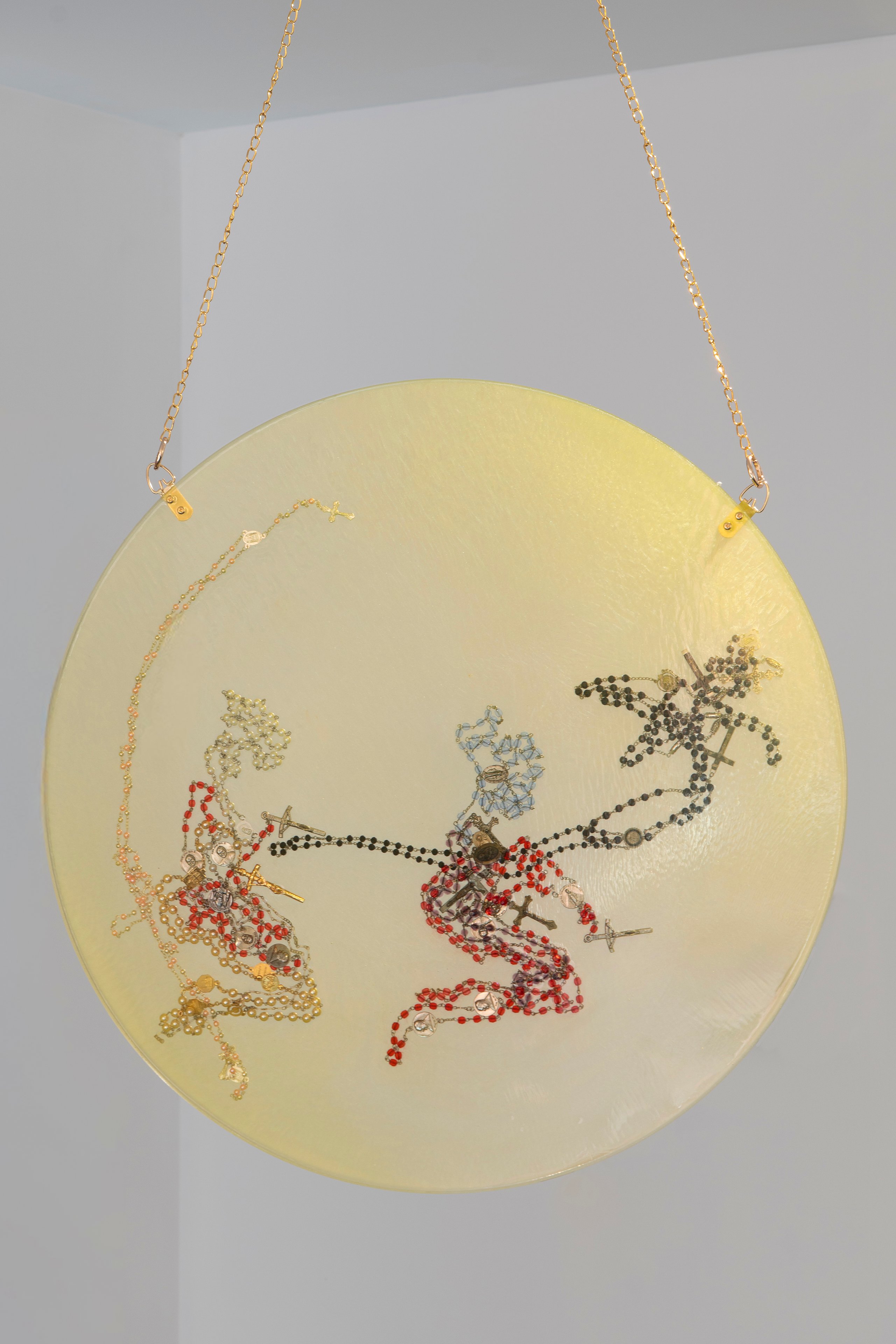
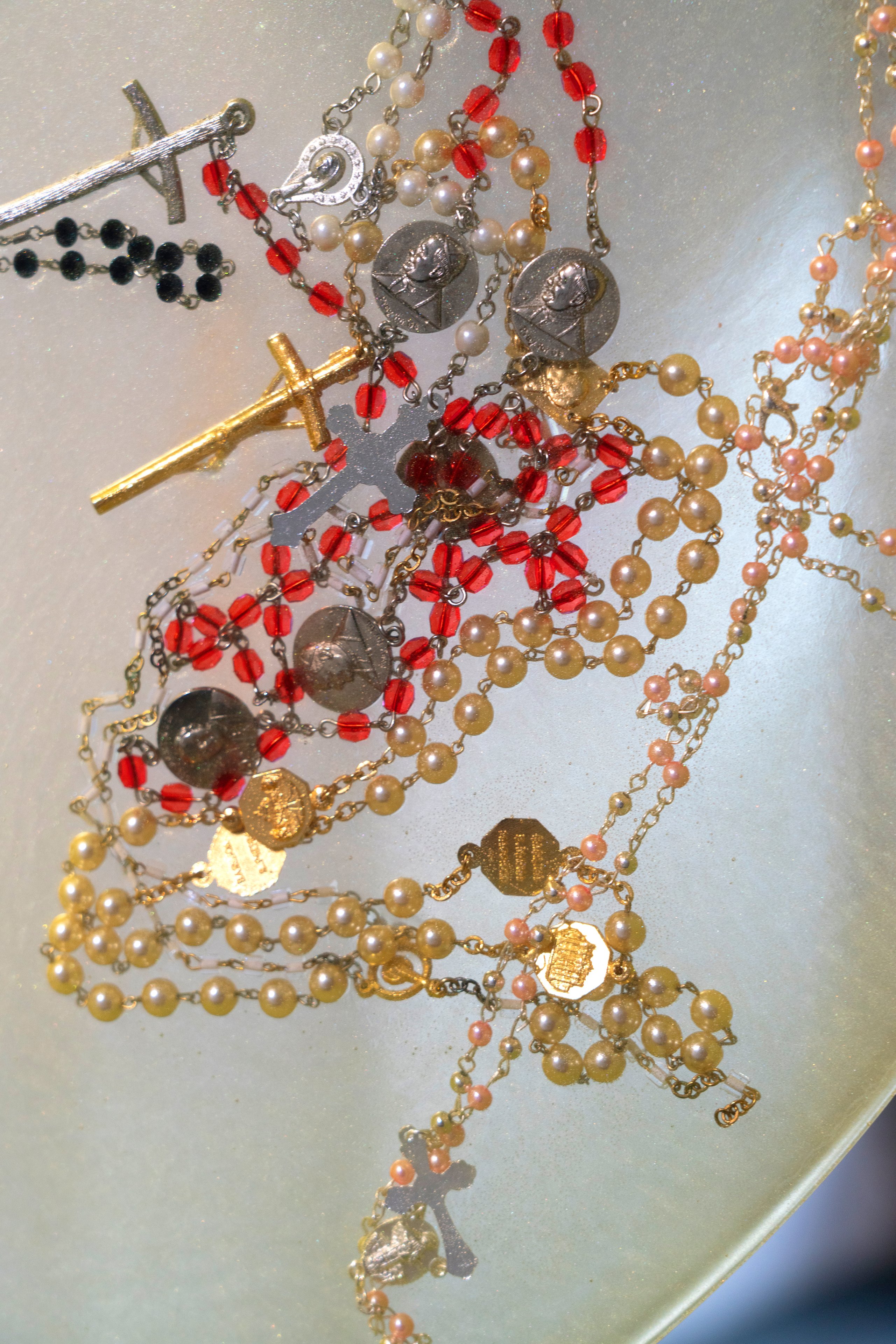
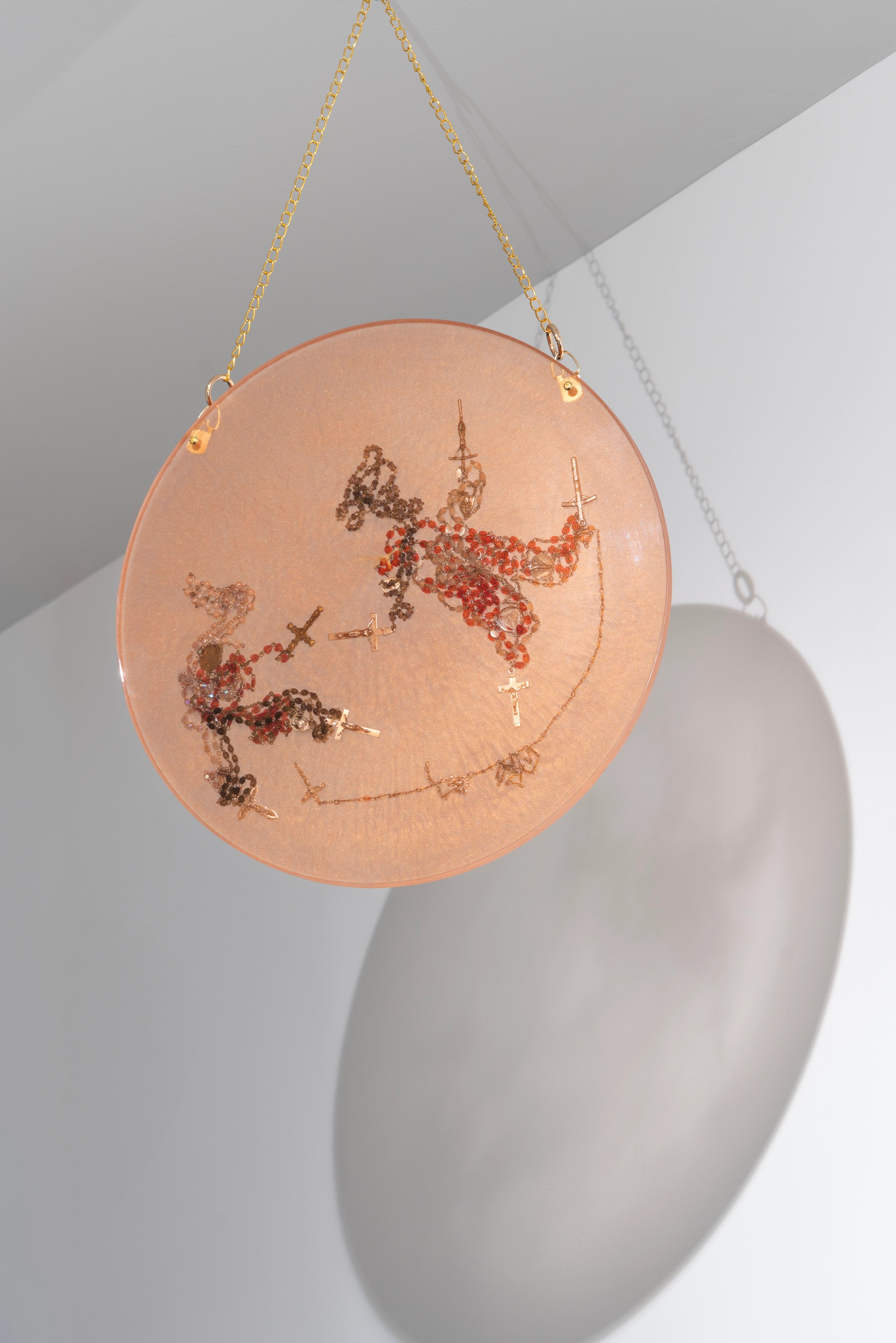
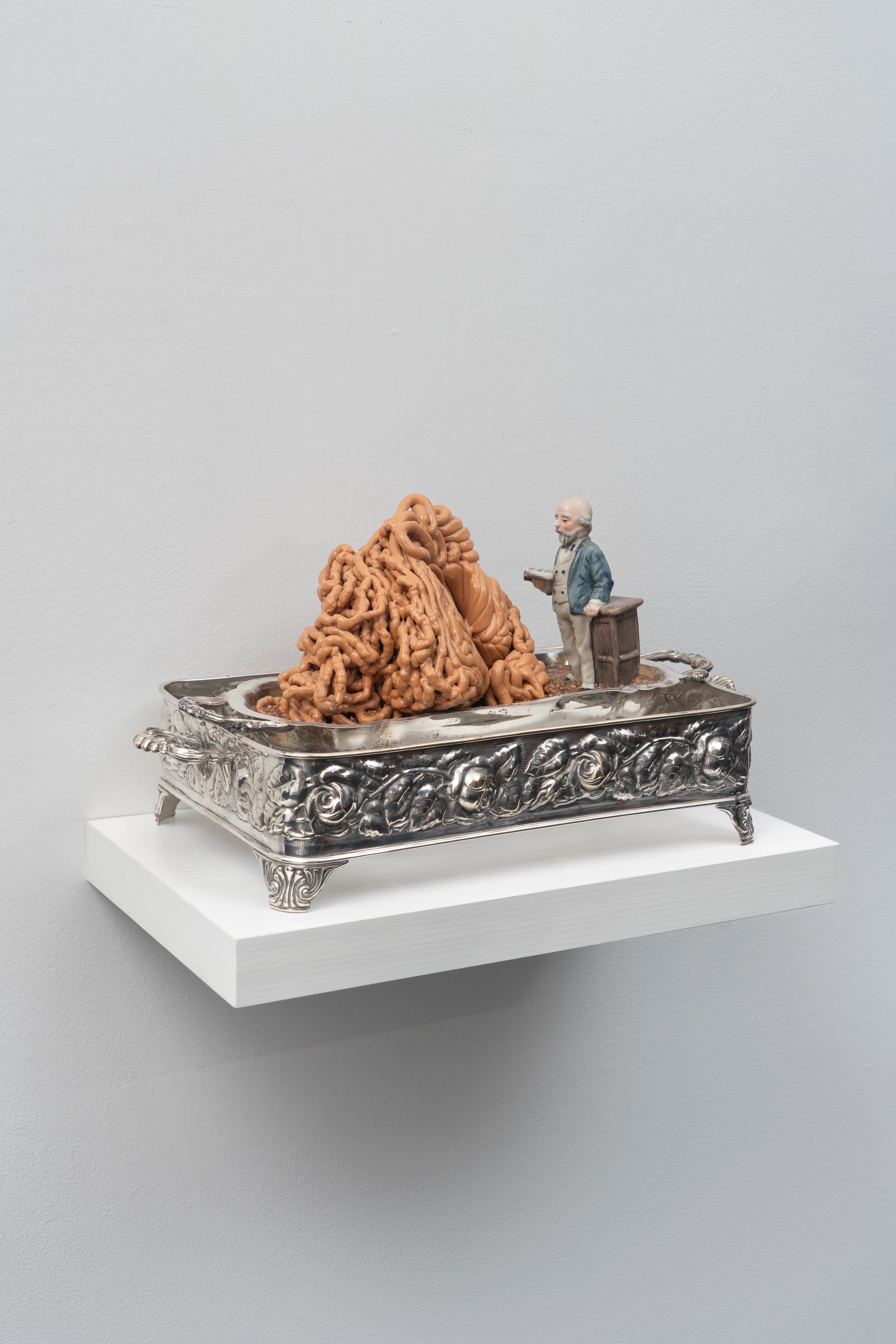
The exhibition consists of a new body of work by Aviva Silverman and is curated by Harry Gould Harvey IV.
Hanging near the windows are translucent amber, pinkish and light green discs, each one containing rosary beads arranged into a scene. Acquired from convent sales, the beads are suspended in resin and look as though they are held in place by the dead skin cells of the diligent pray-er who fingered them, perhaps the nun who once owned them. Each tableau depicts a pair of figures locked into an exchange – with each other, but also with furniture, the landscape, drones and other readymade weapons.
On the little outcropping from a side wall, titled The Resurrection of the body need not be postponed until after death, it can happen at any moment, stands a pre-fab miniature of a bald guy with rosy cheeks, his book held open and propped on his belly in a classic orator’s pose. Atop two nesting silver serving dishes sits his interlocutor, taller than him and many times the mass: a greige lump of plastic squiggles. Heaped up like brains or hamburger meat, it is made out of the melted discards of plastic religious figurines Silverman bought from factories in Italy.
On either side of the hallway are depictions of the artist’s parents, rendered in pastels as cloud-masses in the style of Tibetan medical drawings. Titled Mother, Father, Silverman did these drawings on shooting range paper at age twenty, and included them here almost two decades later. Just beyond, two figurines, half a foot tall, representing the artist and their lover, are poised on either end of a clear plexiglass plinth. Titled Your Attention is a Gift, the figures appear to float in mid-air; their existence consists of the chairs they sit on, a tiny box of dice, a butterfly, and the circular playing cards stretching out between them to form a bridge of possibility.
On the precipice of the darkness sits The Last Instrument, a collection of stacked-up speakers playing a sine-wave score interlaced with a text piece by Early Shinada titled, OVER_CLIFF VELOCITY. The speakers act as a gateway into a black-walled, black-floored space, all the better to expose your brainstem to the incoming audiovisual stream. Spreading across the ceiling is a cleanly limned diagram of the human body’s nervous system, created from model railway tracks and kitted out with sound-responsive LED lights. Within its precise geometric channels, known and unknown signals pop and flare and chase their own tails as it listens to the room. Titled Canticle of the Sun, this flickering glyph mirrors the un-visible you.
Consider the old adage. But consider re-writing it, or re-singing it; consider rearranging its constituent sounds or recombining its thought-molecules: the cure is [blank] than the disease.






















The exhibition consists of a new body of work by Aviva Silverman and is curated by Harry Gould Harvey IV.
Hanging near the windows are translucent amber, pinkish and light green discs, each one containing rosary beads arranged into a scene. Acquired from convent sales, the beads are suspended in resin and look as though they are held in place by the dead skin cells of the diligent pray-er who fingered them, perhaps the nun who once owned them. Each tableau depicts a pair of figures locked into an exchange – with each other, but also with furniture, the landscape, drones and other readymade weapons.
On the little outcropping from a side wall, titled The Resurrection of the body need not be postponed until after death, it can happen at any moment, stands a pre-fab miniature of a bald guy with rosy cheeks, his book held open and propped on his belly in a classic orator’s pose. Atop two nesting silver serving dishes sits his interlocutor, taller than him and many times the mass: a greige lump of plastic squiggles. Heaped up like brains or hamburger meat, it is made out of the melted discards of plastic religious figurines Silverman bought from factories in Italy.
On either side of the hallway are depictions of the artist’s parents, rendered in pastels as cloud-masses in the style of Tibetan medical drawings. Titled Mother, Father, Silverman did these drawings on shooting range paper at age twenty, and included them here almost two decades later. Just beyond, two figurines, half a foot tall, representing the artist and their lover, are poised on either end of a clear plexiglass plinth. Titled Your Attention is a Gift, the figures appear to float in mid-air; their existence consists of the chairs they sit on, a tiny box of dice, a butterfly, and the circular playing cards stretching out between them to form a bridge of possibility.
On the precipice of the darkness sits The Last Instrument, a collection of stacked-up speakers playing a sine-wave score interlaced with a text piece by Early Shinada titled, OVER_CLIFF VELOCITY. The speakers act as a gateway into a black-walled, black-floored space, all the better to expose your brainstem to the incoming audiovisual stream. Spreading across the ceiling is a cleanly limned diagram of the human body’s nervous system, created from model railway tracks and kitted out with sound-responsive LED lights. Within its precise geometric channels, known and unknown signals pop and flare and chase their own tails as it listens to the room. Titled Canticle of the Sun, this flickering glyph mirrors the un-visible you.
Consider the old adage. But consider re-writing it, or re-singing it; consider rearranging its constituent sounds or recombining its thought-molecules: the cure is [blank] than the disease.





















